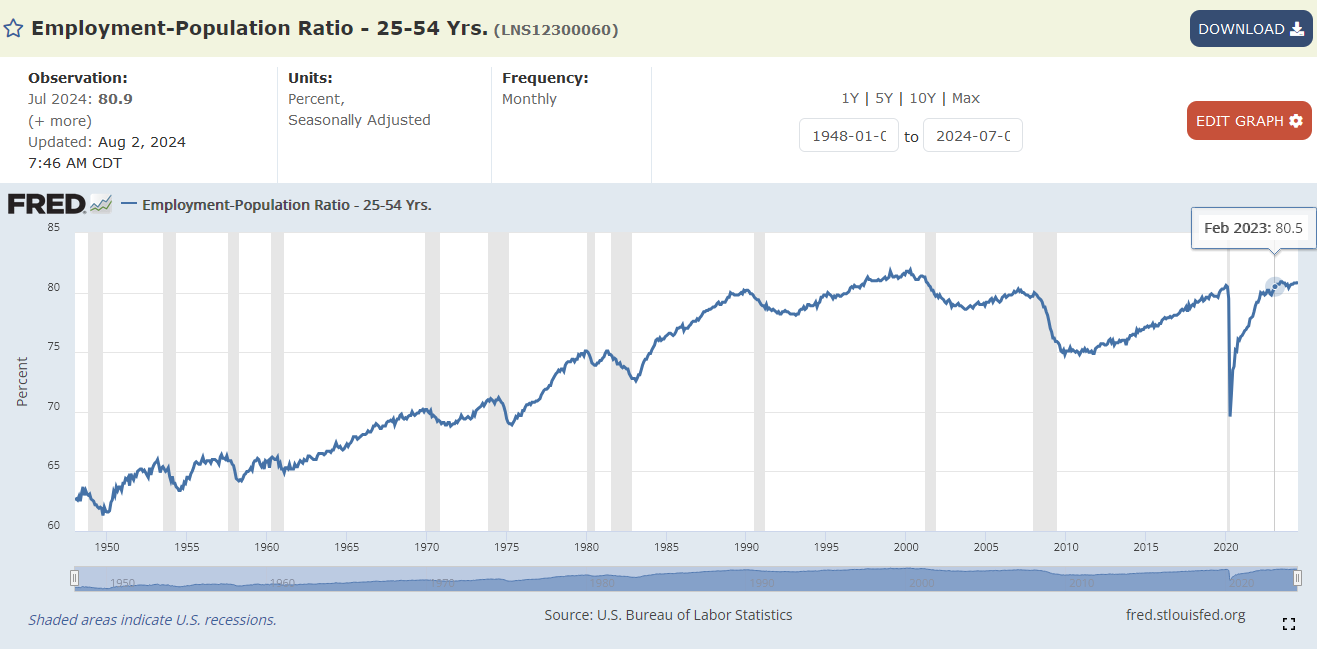
Answers resolve to that month's value of data series LNS12300060: Employment–Population Ratio — 25-54 Yrs. Seasonally Adjusted. See it on BLS | FRED. Answers are rounded to the nearest integer %, with .5% rounding up.
For example, the 2023-02 (Feb 2022) data point was 80.5% ⟶ resolves to 81%.

Zvi's house rules apply.
Sorting answers by A-Z is recommended. That is chronological order.
Explanation
The employment–population ratio (EPOP) or employment rate is the fraction of the population that is employed. It can be obtained from the labor force participation rate (LFPR) and unemployment rate (U) as follows:
EPOP = LFPR * (100% - U)
Personal opinion
I consider the EPOP a better reflection of the state of the labor market because it accounts for discouraged workers who stopped searching for work, and thereby exited the labor force.
Ideally, I would like to look at the version of EPOP obtained from the equivalent of U-6 (see this explanation of different measures of unemployment), which, additionally, considers underemployment in the form of someone working part-time because they can't find a suitable full-time job. But such data is unavailable.
The prime-age (age 25-54) data is used for robustness against demographic changes and cultural changes in retirement patterns.
More info
The BLS's Technical Note, including definitions for "employed" in the household survey (quoted as at 2024-08-29):
People are classified as employed if they did any work at all as paid employees during the reference week; worked in their own business, profession, or on their own farm; or worked without pay at least 15 hours in a family business or farm. People are also counted as employed if they were temporarily absent from their jobs because of illness, bad weather, vacation, labor-management disputes, or personal reasons.
Relevant data series:
- Labor Force Participation Rate: age 16+ (BLS, FRED) | age 25-54 (BLS, FRED)
- Unemployment Rate (U-3): age 16+ (BLS, FRED) | age 25-54 (BLS, FRED)
- Employment–Population Ratio: age 16+ (BLS, FRED) | age 25-54 (BLS, FRED)
See also these questions on Metaculus:
- US Employment–Population ratio below 51.3% in years 2024, 2026, 2030?
- US Employment–Population ratio 5 years after "AGI"?
Fine Print
Fine print moved to this comment below.
Update 2025-23-01 (PST) (AI summary of creator comment): - The market is resolved as N/A due to lack of trading.
Mana used for liquidity has been reimbursed to the trader at 1.25 mana per YES share.
All subquestions associated with this market are also resolved as N/A.
People are also trading
@mods may I have this question (all subquestions) resolved N/A? Because this question had no trading and I want to recover the mana I wasted on liquidity.
I have sent the only trader 100 mana to reimburse his shares at 1.25 mana per YES share.
Fine print
Resolution: Resolves 72 hours after the initial data release:
- Allows for immediate corrections, but not subsequent revisions.
- These are "household survey data", not "establishment survey data", and thus not subject to BLS's annual Benchmark Revisions of establishment survey data.
If Manifold changes to allow resolving to % to a higher precision, then I will use the higher precision and will no longer round data points to the nearest integer % when resolving.
Minor changes in definition of data series LNS12300060:
In the past, the data series had often undergone minor changes in definitions.
I will continue to resolve this question based on LNS12300060, regardless of future minor changes in definitions.
A change is minor as long as BLS continues to report it as data series LNS12300060: Employment–Population Ratio — 25-54 Yrs. Seasonally Adjusted.
Grammatical changes to the name of the data series are minor.
Substantive changes in definition of data series LNS12300060:
Age limits:
The lower age limit changed to within [23, 27] (inclusive of endpoints) is a minor change; outside that range would be a substantive change.
The upper age limit changed to within [50, 60] (inclusive of endpoints) is a minor change; outside that range would be a substantive change.
In case of substantive changes, I will resolve based on Zvi's house rules. This includes allowing commenters to build models of what the data point "should have been", and allowing a market consensus to form.
Meta
Date format: yyyy-MM
Zvi's house rules apply. The resolution is objective (unless the data series LNS12300060 changes substantively), so I may trade.
For each answer, mods may resolve (to %) 72 hours after the corresponding data release.
If there is demand, then I could add answers (and extend the market) for:
- [ ] next 4 months
- [ ] next 4 quarters (2024-09, 2025-03, 2025-06)
- [ ] next 4 years (2026-12, 2027-12)
- [ ] next 4 leap years (2036-12)
The resolution criteria is now finalized.